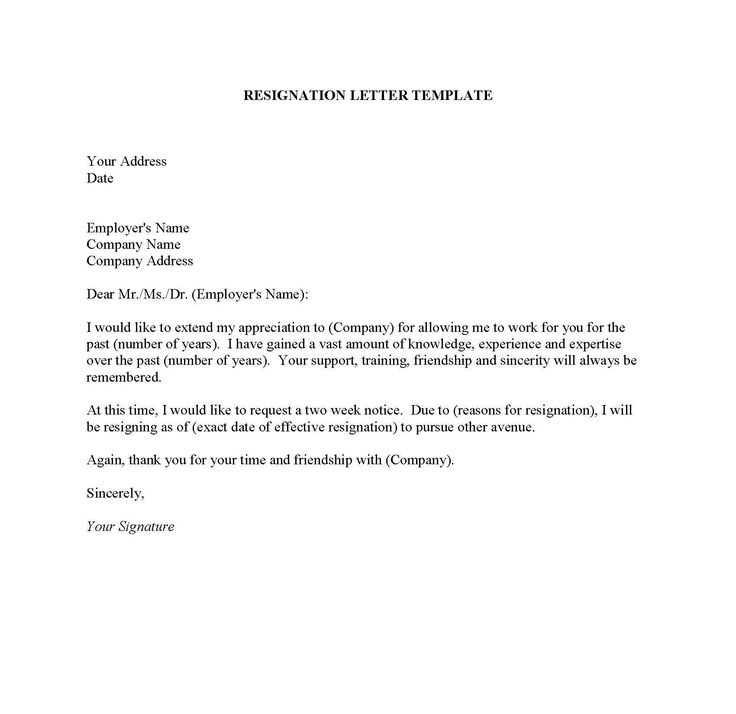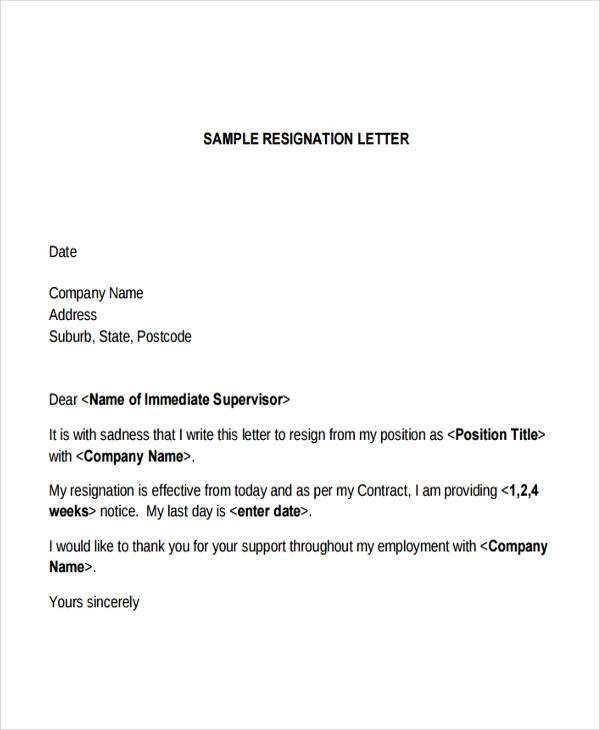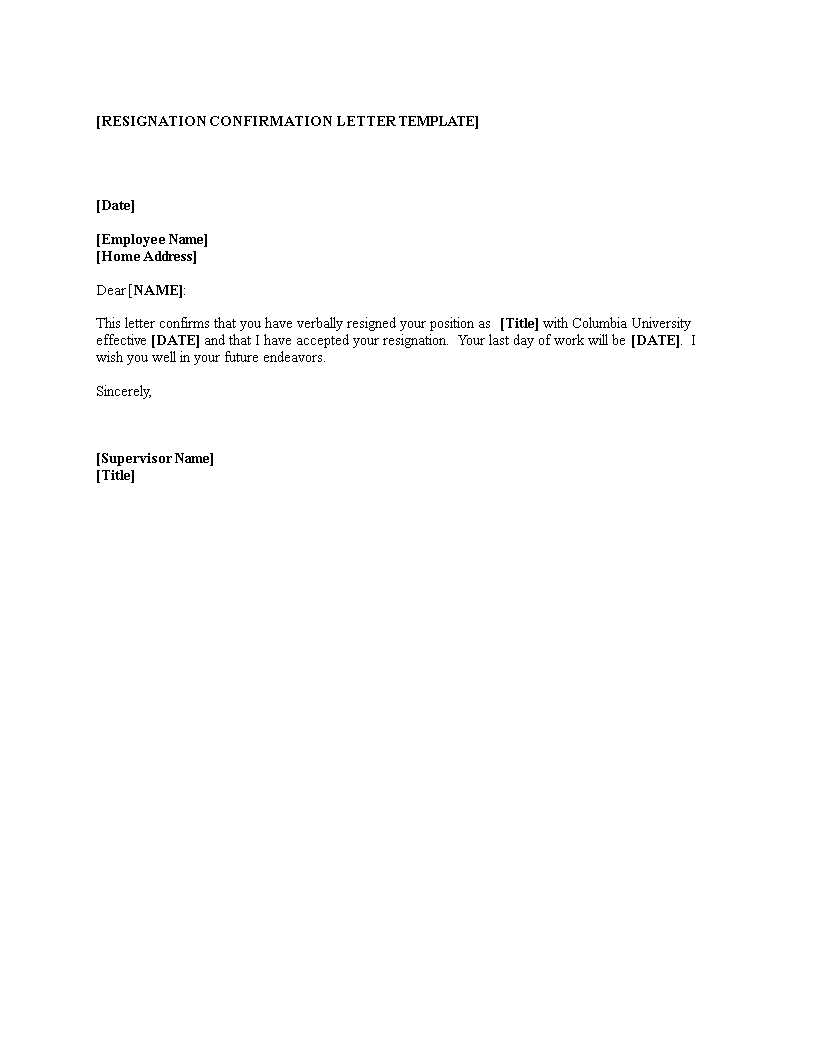Blank resignation letter template

Write a clear and direct resignation letter with this simple template. Avoid unnecessary details, and focus on being professional and concise.
Start by addressing your supervisor, then state your intention to resign and include your final working day. Keep your tone polite and respectful, as this letter will serve as a formal notice of your departure. Make sure to express gratitude for the opportunities you’ve had during your time at the company.
Finish by offering to assist with the transition process, if appropriate, and leave your contact details for future communication. This approach will ensure a smooth and professional exit from your position.
Here are the revised lines, based on your requests:
Begin your letter by stating your resignation clearly and respectfully. Include the specific date when you intend to leave. This ensures that your intentions are understood right away.
Follow with a brief acknowledgment of the company’s positive impact on your career, but keep it concise. Express appreciation without going into too much detail.
Next, mention your willingness to assist in the transition process. Offering help with training or passing on your responsibilities demonstrates professionalism and respect for the organization.
End the letter with a simple, positive statement. A wish for the company’s future success can leave a lasting good impression, showing your appreciation for your time there.
- Blank Resignation Letter Template
A resignation letter should be clear, concise, and professional. Here’s a template to help you craft your own:
Dear [Manager’s Name],
I am writing to formally resign from my position as [Your Job Title] at [Company Name], effective [Last Working Day, typically two weeks from the date of this letter].
I have enjoyed working at [Company Name] and appreciate the opportunities to grow both personally and professionally. I am grateful for the support of my colleagues and management during my time here.
Thank you for your understanding. Please let me know how I can assist in making this transition as smooth as possible.
Kind regards,
[Your Name]
Tailoring your resignation letter to fit your unique circumstances helps maintain professionalism and leaves a positive impression. Focus on being clear, respectful, and concise, while addressing the specifics of your situation.
1. Be Transparent About Your Reason for Leaving
If you feel comfortable, briefly mention the reason for your departure. Whether it’s for personal growth, relocating, or another opportunity, keep the tone neutral and non-judgmental. Avoid negative language or complaints, as this could affect your future references.
2. Adjust the Tone According to Your Relationship with the Employer
- If you’re leaving amicably, you can express gratitude for the experience and team support.
- If the departure is more difficult, remain polite but focus on the formalities and necessary details, avoiding emotional language.
- For a transition within the same organization, make sure to express willingness to assist in the handover process.
3. Set Clear Dates and Terms

Clearly state your last working day, as per the notice period in your contract or a mutually agreed-upon date. If you’re able to offer assistance during the transition, mention it explicitly.
4. Offer Assistance if Possible
Providing support during the transition process shows professionalism. You can mention specific tasks you’re willing to help with, like training a successor or organizing handover notes.
5. Keep It Brief and Professional
- Avoid unnecessary details about personal matters or future plans.
- Focus on the essential information, such as your reason for resigning, your last working day, and any commitments to assist with the transition.
Customize your resignation letter to reflect your circumstances while maintaining professionalism. This ensures a smooth exit and keeps the door open for future opportunities.
Clearly state your intention to resign. Specify your job title and the date of your last working day. This helps your employer understand the exact timeline of your departure.
State Your Reason for Leaving
If appropriate, mention why you are resigning. Be brief and professional. Avoid negative language; focus on the positive aspects of your decision, such as pursuing new opportunities or personal growth.
Offer to Assist with Transition
Offer your help in making the transition smooth, such as training a replacement or completing ongoing projects. This shows your commitment to leaving on good terms.
Express gratitude for the opportunities you had in the role. Mention specific experiences or skills you gained. This leaves a lasting positive impression.
End with a professional closing, such as “Sincerely” or “Best regards,” followed by your name.
Common Mistakes to Avoid When Writing a Resignation Letter
Be direct and clear about your decision to resign. Avoid vague language that may confuse your employer about your intentions. State your resignation explicitly and avoid leaving any room for ambiguity.
Do not vent frustrations in your letter. It’s important to maintain a positive tone, even if your experience has been less than ideal. Express gratitude for the opportunities you’ve had and leave on a professional note.
Don’t forget to include the necessary details, such as your last working day. This ensures clarity and helps your employer plan accordingly. Including your resignation date and specific notice period is critical for smooth transitions.
Refrain from over-explaining your reasons for leaving. While it’s acceptable to provide a brief explanation, avoid going into unnecessary detail. Keep it concise and professional.
Avoid using inappropriate language or humor. A resignation letter is a formal document, and it’s best to keep it respectful and straightforward. Lighthearted comments can often be misinterpreted.
Do not neglect to proofread your letter. Mistakes in spelling, grammar, or formatting can make your resignation appear careless. Take the time to review your letter before sending it.
| Common Mistakes | How to Avoid Them |
|---|---|
| Being unclear about resignation | State your resignation clearly and directly |
| Expressing frustrations | Maintain a positive and professional tone |
| Missing details like last working day | Include your last day of work and notice period |
| Over-explaining reasons for leaving | Keep your explanation brief and to the point |
| Using inappropriate language or humor | Stick to a formal and respectful tone |
| Not proofreading | Double-check for grammar and spelling errors |
How to Professionally Address Your Employer in a Letter
Address your employer using their formal title and full name. This creates a tone of respect and professionalism from the outset. If you are unsure of their title, “Mr.” or “Ms.” followed by their last name is a safe choice.
Start the letter with “Dear [Title] [Last Name],”. If you are familiar with the employer but still want to maintain formality, “Dear [First Name]” is also appropriate in certain cases, but always err on the side of formality unless instructed otherwise.
Keep the salutation brief, avoiding unnecessary words or phrases. Using “Dear” and the person’s title ensures clarity and respect without sounding overly casual or distant.
| Formal Title | Example |
|---|---|
| Mr. | Dear Mr. Smith, |
| Ms. | Dear Ms. Johnson, |
| Dr. | Dear Dr. Adams, |
Make sure your address is correct and up to date, ensuring that you are addressing the person by their preferred title. If you are uncertain, opt for the most formal option to show professionalism. If you have had a more informal relationship with the person, transitioning to a first-name basis can be done, but it should be in line with their preference.
Avoid informal greetings like “Hey” or “Hi” in a formal resignation letter, as they can undermine the tone of respect you want to establish. Stick with formal language for a polished and professional approach.
Begin your resignation letter by expressing appreciation for the opportunities you’ve had during your time with the company. Acknowledge the value of the experiences and the growth you’ve gained. This will set a respectful tone for the letter.
Maintain Professional Tone
Use a formal, yet friendly, tone throughout the letter. Avoid casual language and focus on maintaining a respectful, courteous voice. The goal is to leave a positive impression, which could benefit your professional reputation in the future.
Offer Assistance During Transition

Be open to assisting with the transition process. Offering to help train a successor or provide support in handing over responsibilities shows goodwill and ensures you leave on a helpful note.
By showing gratitude, maintaining professionalism, and offering support, you can ensure your resignation is viewed positively and professionally.
Submit your resignation as soon as you’ve made a firm decision. Ideally, give at least two weeks’ notice, unless your contract specifies a different time frame. This shows respect for your employer and helps maintain professionalism.
Choose the right moment to inform your boss. Do so privately in a face-to-face conversation or via video call if you’re working remotely. Avoid sending the resignation through email or text first, as it may come across as impersonal. If face-to-face communication isn’t possible, email should be your second option. In the email, clearly state your resignation and the last day you’ll be working.
Be prepared to discuss the reasons for your departure, but keep it brief and diplomatic. Focus on the positive aspects of your experience and thank your employer for the opportunity. Do not use this time to air grievances or speak negatively.
After submitting your resignation, offer help with the transition. This could involve training a replacement or creating handover documentation. This shows your commitment to leaving on good terms.
Once your resignation is accepted, you may be asked to sign a formal resignation letter or complete additional paperwork. Make sure to follow through with any necessary administrative steps to close the chapter smoothly.
Steps to Write a Blank Resignation Letter
To write a resignation letter, follow these steps:
- State your intention to resign clearly. Begin with a direct statement, such as “I am resigning from my position as [Job Title] effective [Date].” Make sure the date is at least two weeks from when you send the letter to provide notice.
- Express appreciation. Acknowledge your time at the company, highlighting positive experiences. A sentence like, “I have enjoyed working with you and appreciate the opportunities for growth,” shows respect without going into excessive detail.
- Keep it concise. Avoid long explanations or personal grievances. Focus on professionalism and avoid mentioning reasons for your departure unless it feels necessary.
- Offer assistance with the transition. A line such as, “I am happy to assist with the transition process,” shows cooperation. You may also specify your willingness to train a replacement or help wrap up projects.
- End on a positive note. A brief sentence like, “I wish the company continued success,” leaves the door open for future interactions and maintains a positive relationship.
- Sign your letter. Conclude with “Sincerely,” followed by your name and contact information if required. Keep the tone formal and professional.
By following these steps, your resignation letter will reflect professionalism and respect towards your employer while maintaining positive connections for the future.